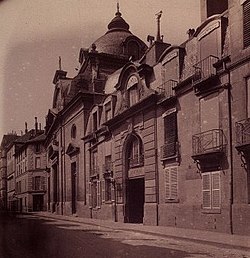
Back Klášter Penthemont Czech Abtei Penthemont German Abbaye de Penthemont French Abbaye de Penthemont Swedish
Abbaye de Penthemont | |
 Pentemont Abbey from Rue de Grenelle in 1898 by Eugène Atget | |
| Monastery information | |
|---|---|
| Full name | L'Abbaye Royale de Notre-Dame de Penthemont[1] |
| Order | Cistercians |
| Established | 1217 |
| Disestablished | 1790 |
| Diocese | Beauvais (1217–1672), Paris (1672–1790) |
| People | |
| Founder(s) | Philippe de Dreux, Milo of Nanteuil |
| Important associated figures | Joséphine de Beauharnais, Louise Adélaïde de Bourbon, Louise d'Esparbès de Lussan, Martha Jefferson Randolph, Mary Jefferson Eppes, James Smithson |
| Architecture | |
| Status | disestablished |
| Heritage designation | Inscribed MH(1983) Facade and roof of the Court of Honor Inscribed MH(1992) Central salon and first floor[2] |
| Architect | Pierre Contant d'Ivry (1756), Victor Baltard (1844) |
| Groundbreaking | 1756 |
| Completion date | 1783 |
| Site | |
| Location |
|
| Coordinates | 48°51′25.1″N 2°19′18.6″E / 48.856972°N 2.321833°E |
Pentemont Abbey (French: Abbaye de Penthemont, Pentemont, Panthemont or Pantemont) is a set of 18th and 19th-century buildings at the corner of Rue de Grenelle and Rue de Bellechasse in the 7th arrondissement of Paris. The complex had originally been a Cistercian monastery of nuns. The abbey was founded near Beauvais in 1217 and moved to its current site in Paris in 1672 at the behest of King Louis XIV. A reconstruction of the abbey was initiated in 1745 by the Abbess Marie-Catherine Béthisy de Mézières and work was completed in 1783. In the late 18th century, the abbey was one of the most prestigious educational institutions in Paris for daughters of the elite, including two of Thomas Jefferson's. The abbey also provided rooms for ladies of good standing who were in search of rest, including Joséphine de Beauharnais when the case of her separation from her first husband was heard.
The abbey was disestablished during the French Revolution and the buildings were turned over to military use, first as the home of the National Guard, then the Imperial Guard, and later the Cent-gardes. It continues to be occupied by the Ministère de la Défense with the exception of the former chapel, which since 1844 has been a Protestant church, the Temple de Pentemont. In August 2014 the Ministry of Defence, facing budget cuts due to austerity policies, sold the buildings to a real estate investment trust, Foncière des 6ème et 7ème Arrondissements de Paris, with plans to move all ministry offices out of the abbey by the end of October, 2016.[4]
- ^ Graves, Louis (1855). Précis statistique sur le canton de Beauvais, arrondissement de Beauvais (Oise). p. 192.
- ^ Base Mérimée: PA00088671, Ministère français de la Culture. (in French)
- ^ "Penthemont : un ensemble immobilier d'exception". Le portail des ministères économiques et financiers. Ministère de l'Économie, de l'Industrie et du Numérique.
- ^ "L'Etat a vendu l'ensemble Penthemont dans le 7e". LaVieImmo.com.
